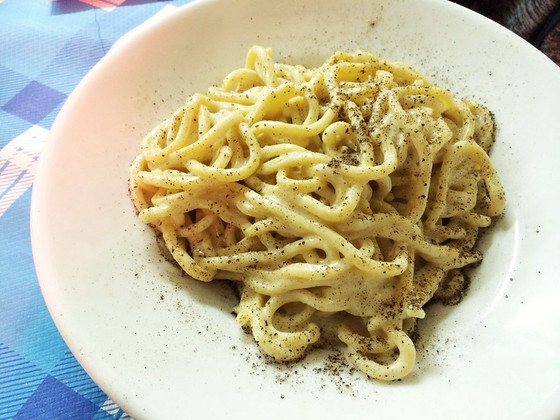Physicist reveals 'scientifically perfect' recipe for pasta

Physicists at the Max Planck Institute for the Physics of Complex Systems, in collaboration with researchers from the University of Barcelona and the Austrian Institute of Science and Technology, have published a recipe for making
[2501.00536] Phase behavior of Cacio and Pepe sauce
https://arxiv.org/abs/2501.00536
Physicists develop the 'perfect' recipe for a well-known Italian pasta dish
https://phys.org/news/2025-01-physicists-recipe-italian-pasta-dish.html
Cacio e pepe is a specialty pasta dish from Rome, the capital of Italy. As its name means 'cheese and pepper,' it is made by mixing boiled spaghetti with Pecorino Romano cheese and sprinkling it with plenty of pepper. A research team from the Max Planck Institute for the Physics of Complex Systems took a three-pronged approach to uncovering the perfect recipe for cacio e pepe.

By
First, the team mixed cheese with fixed amounts of water and varied the temperature and starch concentration of the water. The temperature was varied in 5°C increments from 50°C to 95°C, and the starch concentration was adjusted to three levels: 0% fresh water, regular pasta water, and 'risottota,' a type of pasta water made by boiling it down by one-third to concentrate the starch. Each sample was photographed and the size and shape of the cheese chunks were analyzed.
The results showed that in the case of 0% starch (no starch), large clumps of cheese formed suddenly at around 65°C. And while cheese clumps formed in regular pasta boiling water, they remained stable and the clumps became smaller up to 70°C. Furthermore, in the case of risotto, the cheese remained relatively stable even at a high temperature of 95°C, and clump formation was suppressed.

Next, to investigate the effect of cheese protein concentration on the state of the sauce, the research team fixed the starch concentration at 1% and performed experiments varying the water-to-cheese ratio and temperature.
As a result, it was found that the phase behavior of the sauce changes significantly depending on the mass ratio of cheese to water. The following phase diagram was created from the obtained data, showing the relationship between protein mass fraction and temperature. This phase diagram shows that the most stable state is obtained when the protein mass fraction is approximately 0.134, which is close to a 1:1 ratio of water to cheese.

In addition, the lowest point of the parabola in the above diagram is at about 60℃, and it was found that the behavior of the water and cheese changes significantly at this temperature. This shows that even if the ratio of cheese to water is appropriate, if the temperature is too high, phase separation will occur and the sauce will separate.
The team also developed a minimal model to theoretically explain this phenomenon, treating the proteins in cheese, such as casein and whey , and water, which contains starch and salt, as an 'effective solvent,' as a two-component system, and analyzed the interactions between them.
From these results, the research team argues that using cheese and water in a 1:1 ratio and cooking at around 60 ° C is an important condition for making a stable sauce when making cacio e pepe. In addition, the starch concentration of the water added plays a crucial role in the stability of the sauce, and if the starch concentration is less than 1%, the sauce will separate, and if it exceeds 4%, the cheese protein will aggregate when cooled and the sauce will harden. In other words, the recipe obtained from the chef's experience of 'adding pasta boiling water and making a sauce over low heat while slightly reducing it' was scientifically correct.
The research team also lists detailed analysis of the effect of starch on the viscosity of the sauce and the possibility that peppercorns act as agglomeration nuclei as future research topics. The research team also positioned this research as 'an example of how to transform pure passion for cooking into scientific insight and find a way to make a complex cooking process feasible in an ordinary kitchen,' suggesting that this research approach could be applied to understanding and improving other dishes.
Related Posts:







